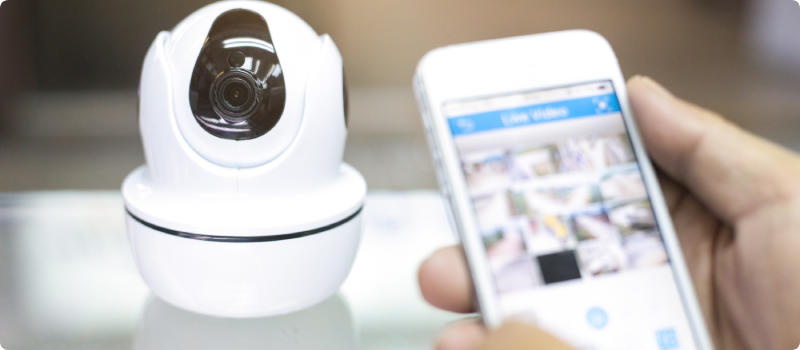Reviewing the Best Home Security Systems
Updated September 1, 2024 . AmFam Team
As home security systems become more affordable and continue to improve, it can be difficult to see the differences between each product. With Wi-Fi enabled home hubs like Google Home and Amazon Alexa, new home security hardware isn’t just revolutionizing home alarm systems, they’re reinventing home automation with each new release. If you’re left wondering how to navigate your way through the various options, packages and monitoring plans available, we’re here to help.
DIY Home Security Systems Are Winning
According to SafeWise.com, competition in the smart home security sector is heating up. Consumers are looking for security systems that can hook into their existing home hub like Google Assistant or Apple HomePod. Home security systems that are easy to set up and install are offered by many of the industry’s major players because DIY home security systems are saving consumers money.

How to Choose a Home Security System
Weighing products on several levels, the winners in today’s marketplace all emerged with a few important common features. Do-it-yourself home security systems weighed heavily, but ease of use did too. Products with easy-to-understand control panels, and robust basic packages that include video doorbells also won high praise.
Here are some ideas for choosing a home security system:
Compare costs for the system and monthly monitoring
People want to get the most for their money, so finances weigh heavily on consumer choice. When considering your options, you’ll need to look at both the initial cost of the hardware and the monthly monitoring service fee as well.
Explore features and functionality
Home automation is a word receiving a lot of airplay lately. And if you study the way consumers are buying home security systems, you’ll find they’re leaning into security systems that work well with their home hub. Hooking their phones into video feed from smart doorbells, people are seeking out products that remotely monitor and even unlock their homes.
High resolution video and two-way audio systems are among the most popular features today. And motion sensors that activate cameras attached to floodlights and stream video to the cloud are also popular.
Smart locks can be programmed so a door opens at the tap of a button on your phone. You’ll also be able to get real-time details through video doorbells and other monitoring devices. Plus, if a smoke alarm’s battery should start to fail, you’ll be notified.
Review connectivity — at home and away
Consumers want to tell their home what to do. When you’re walking out the door, you can ask your home to arm itself — and it will. Remote connectivity offers them the ability to remotely manage their home as well. Home security products that are gaining traction today are able to operate in real-time whether the owner’s home or away.
Clock emergency time response
Knowing that your monitoring service will be able to react quickly and decisively is a key reason people buy alarm systems. The best performers won the day because their systems are able to communicate via cell phone — thwarting thieves that cut land lines to disable the alarm. Companies that have strong response times are well-organized and able to respond in a moment’s time.
Look at the customer service experience
Getting answers when they need them is another central reason consumers are vying for certain brands. The winners were able to manage technically complex issues easily and were also adept at helping the user through common issues and DIY installation hiccups.
Weigh ease of use
Many consumers rated their ability to use the system as a key factor when determining which home security group to go with. Simple, user-friendly control panels help people to feel comfortable with the system. And hooking into a voice-activated hub to manage their home’s security system was definitely a winner.
Demand DIY
There was a time when installing a home security system was complicated and required trained personnel to complete the work. But those days are gone. DIY installers are finding the process simple and straightforward. And products that lead the pack are succeeding because getting the alarm system up and running is a breeze.
Consider design and style
Winners of this category carried the day because their user interfaces were intuitive. And because these systems will be encountered by residents and visitors alike, products with a strong but easy-to-navigate operating system are well-received.
Look for contingency plans
If your home alarm system only works when the power’s running, that may be a problem. Groups that have built backup plans into their home’s security systems to tackle power outages are getting attention. When the phone lines go down or other issues thwart communication, the group that can keep surveillance up and running is going to be the most valuable.

Home Security Systems to Consider
By comparing the industry favorites, we’re able to see how products leverage certain tech to maintain their edge. And by looking closely at how these products differ, you’ll be able pick a product that’s right for your needs and your home.
Because we at American Family believe in innovative home technology, we partnered with some of the leading suppliers to offer you solutions that go above and beyond to protect you and your family — check out these partnerships for more information:
Frontpoint Home Security
Receiving high marks for best DIY installation option, Frontpoint really shines when it comes to caring for its customers. Customer service representatives are said to be courteous and knowledgeable — and their product is endorsed by American Family Insurance. By partnering with Frontpoint, we’re able to bring our customers a state-of-the art home security system at a discount as well.
Frontpoint features crash and smash protection which prevents the system from being disabled if the main control panel is destroyed. Their affordable annual fee, along with connectivity into Amazon Alexa and Google Home, this system boasts compatibility. Like the other leaders, Frontpoint’s able to hook into smart thermostats and smoke/fire detectors, offering your home protection against more than theft.
Frontpoint’s received some flack for their relatively high potential monitoring costs. Although they don’t offer professional installation, you can work with American Family and our installation partner HelloTech to get the Frontpoint system you need installed quickly and efficiently.
Ring Video Doorbell
The easy-to-install Ring Video Doorbell lets you answer the door from anywhere using your smartphone. They’ve made their mark with the video doorbell, but the rest of their home security system is really worth considering as well.
Dedicated to reducing crime in neighborhoods, the Amazon-owned Ring has launched a Neighbors social network that has caught the attention of homeowners across the US. The Neighbors utility in the Ring app connects owners and neighbors living nearby together. Sharing images, descriptions and details of alleged perpetrators and their tactics, the network has become a deterrent to crime in some areas.
Because people are busier now than ever before, Wi-Fi enabled home connectivity is more valuable than it’s been previously. And with the chance to get the community informed in ways that weren’t possible historically, Ring’s making an impact that’s worth considering.
Get the Installation Help You Need With HelloTech
From installing your Ring video doorbell to helping you set up smart home, our smart home partner HelloTech helps you move out of the DIY (do it yourself) space and into the DIFM (do it for me) space. HelloTech’s an on-demand, in-home tech support solution that’ll install and set up your protection devices — and educate you along the way — so you feel empowered to take it from there.
As these security systems are becoming more affordable, you may also benefit from homeowners insurance discounts which also sweetens the deal. The savings can help pay for the cost of the home security system, and these innovative technologies will help you to feel more informed when away — and safer when you’re at home.
As you’re considering your home security options, remember to connect with your American Family Insurance agent. They can help you align your security service and monitoring products to help maximize your benefit and make your home safe. And once you’ve got everything up and running, you’ll find real peace of mind — knowing that your home, and everything that means so much, is well-protected.
This article is for informational purposes only and based on information that is widely available. We believe this information is accurate but do not make any guarantees or promise any results based on this information.
Tools & Resources
NextScripts
JSS component is missing React implementation. See the developer console for more information.

